The Panoramic View of Ecuadorian Soil Nutrients (Deficit/Toxicity) from Different Climatic Regions and Their Possible Influence on the Metabolism of Important Crops
Abstract
1. Introduction
2. The Climate in Ecuador
- Coastal Climate. This region has a tropical or equatorial climate, whose average annual temperature varies between 22 and 26 °C. It is characterized by constant rainfall unevenly in different places and throughout the year; the main rainy months are between December and mid-May, a period considered winter. This inequality in rainfall is due to the effect of the marine currents of Humboldt and El Niño. Mainly, two major climatic zones of the Ecuadorian Coast are considered: hot-cool-dry and hot-hot-humid;
- Andean Climate. The climate of the Andean region is very varied, due to the presence of the Andes Mountain range and the winds that blow through the valleys and plains. The following climates, known as climatic floors or steps, are located in this region: tropical Andean, subtropical Andean, temperate, cold, and glacial;
- Amazonian Climate. In this region, the climate is the same as that of the internal coast—hot, hot-humid. The temperature varies between 22 and 26 °C. This region is the wettest region of the country being an area subject to abundant precipitation (>3.000 mm/year). The flanks of the Andes form a densely cloudy area because large masses of steam from the Atlantic and the Amazon jungle condense.
3. Agricultural Soils of the Ecuadorian Regions
3.1. Soil Characteristics of the Coastal Region
3.2. Soil Characteristics of the Andean Region
- (a)
- Cold peaks of the Andean Mountain ranges, with inherited landscapes and paramo landscapes with cold or very cold climates and daily night frosts, with volcanic cones of different ages and little evolved black soils with high contents of organic matter. The climate does not favor agricultural activity, but these areas are used for extensive and localized sheep grazing;
- (b)
- External slopes of the Andes, with vigorous and highly dissected modeling on various ancient rocks. The climate is humid to very humid with the presence of heavy cloud cover, conditions that have favored the formation of perennial arboreal zones. The soils are ferralitic with a partial cover of recent volcanic ash and are rejuvenated by erosion;
- (c)
- Inter-Andean basins in the north of the Sierra with volcano-sedimentary fills, where the volcanic morphogenesis promoted by the presence of large recent and active stratovolcanoes is evident. The soils in this area have developed widespread pyroclastic coatings and are subject to intense agricultural activity;
- (d)
- Inter-Andean basins in the center of the Sierra with ancient, volcanic, and metamorphic basements, where there are no volcanoes or recent pyroclastic coatings. The area is fragmented into two sets of parallel sedimentary basins whose coverage is distributed in a topo-climo sequence where the soils of the upper part are ferralitic, often humiferous, those of the middle zone are moderately evolved with mollic or vertic characteristics, and those of the lower zone are little evolved;
- (e)
- Indentations and inter-Andean River valleys with relatively rich alluvial soils in the valleys and on which there is diversified agricultural activity;
- (f)
- Reliefs of the Sierra Austral of ferralitic-fersialitic soils, located in a paleo-topo-climo-edaphological sequence of large valleys and orthogonal depressions where the climatic stratification from humid to arid is clear.
3.3. Soil Characteristics of the Amazonian Region
4. Main Crops of Commercial Interest Cultivated in Ecuador
4.1. Banana (Musa sp.)
4.2. Cocoa (Theobroma cacao)
4.3. African Palm (Elaeis guneensis Jacq.)
5. Soil Characteristics Necessary for the Optimum Cultivation of Crops
5.1. Banana
5.2. Cacao
5.3. African Palm
6. Nutritional Composition of Agricultural Soils
7. Importance of Nutrients in the Plant Metabolome
7.1. Antioxidants as Plant Defense Systems
7.2. Plant Diseases Caused by a Deficit or Excess of Nutrients in Soil
8. Conclusions
Author Contributions
Funding
Institutional Review Board Statement
Informed Consent Statement
Data Availability Statement
Conflicts of Interest
References
- Palma-Henríquez, J. Las regiones naturales. Master’s Thesis, Universidad Nacional de Educacion, Azogues, Ecuador, 2018. [Google Scholar]
- Portilla, F. Introducción. In Agroclimatología del Ecuador; Abya-Yala: Quito, Ecuador, 2018. [Google Scholar]
- Medina Carranco, N.C. Corgánico de la Economía Social de los Conocimientos, Creatividad e Innovación. Título de Ingeniero Estadístico, Universidad Central del Ecuador Universidad Central del Ecuador, Quito, Ecuador, 2019. [Google Scholar]
- Palacios-Estrada, M.; Massa-Sánchez, P.; Martínez-Fernández, V.A. Cambio climático y contaminación ambiental como generadores de crisis alimentaria en la américa andina: Un análisis empírico para Ecuador. Investig. Oper. 2018, 39, 234–249. [Google Scholar]
- Cruzatty, L.C.G.; Vollmann, J.E.S. Caracterización de suelos a lo largo de un gradiente altitudinal en Ecuador. Rev. Bras. Cienc. Agrar. 2012, 7, 456–464. [Google Scholar] [CrossRef]
- Varela, L.A.; Ron, S.R. Geografía y Clima del Ecuador. BIOWEB. Pontificia Universidad Católica Del Ecuador, Quito, Ecuador. 2018. Available online: https://bioweb.bio/geografiaClima.html/ (accessed on 14 December 2022).
- Acaro, L.; Córdoba, A. Evolution in banana exports and impact of economic development, province of El. Rev. Científica 2021, 7, 1558–1577. [Google Scholar]
- Sanchez Mendez, J.A. Suelos Apropiados y Fértiles, para Impulsar el Desarrollo de la Agricultura en la Región Costa del Ecuador. Tenure Thesis, Universidad Técnica de Machala, Machala, Ecuador, 2016. Available online: http://repositorio.utmachala.edu.ec/handle/48000/9845 (accessed on 14 December 2022).
- Calvache-Ulloa, A.M. La Fertilidad de los Suelos del Ecuador, Isotopes in Ecuadorian Agriculture. In Proceedings of the XII Congreso Latinoamericano Agronomía, Quito, Ecuador, 21–23 June 2021. [Google Scholar]
- Bekele, D.; Alemayehu, B. The characteristics, distribution and management of alfisols: A Review. Int. J. Hum. Resour. Manag. 2020, 9, 21–30. [Google Scholar]
- Elizondo-Alvarado, M.J. Suelos De Costa Rica Orden Andisol. Boletín Técnico 2015, 8, 1–2. [Google Scholar]
- Jaramillo, J.D.F. Variabilidad espacial de las propiedades ándicas de un Andisol hidromórfico del oriente antioqueño (Colombia). Rev. Fac. Nac. Agron. Medellín 2009, 62, 4907–4921. [Google Scholar]
- Kissel, R.A.; Parrish, J.T. Chapter 7: Soils of the Southwestern US. In The Teacher-Friendly Guide to the Earth Science of the Southwestern US, 1st ed.; Paleontological Research Institution: Ithaca, NY, USA, 2016; pp. 276–299. [Google Scholar]
- Sigtierras, Sistema Nacional de Información y Gestión de Tierras Rurales e Infraestructura Tecnológica. Memoria explicativa del Mapa de Órdenes de Suelos del Ecuador; Sigtierras: Quito, Ecuador, 2017. [Google Scholar]
- University of Idaho. Ultisols. Soil and Water Systems. Available online: https://www.uidaho.edu/cals/soil-orders/ultisols (accessed on 12 November 2022).
- Aide, M.T.; Aide, C.; Braden, I. Soil Genesis of Histosols and Gelisols with a Emphasis on Soil Processes Supporting Carbon Sequestration. In Environmental Issues and Sustainable Development; Sarvajayakesavalu, S., Charoensudjai, P., Eds.; IntechOpen: London, UK, 2020. [Google Scholar]
- Espinosa, J.; Moreno, J.; Bernal, G. The Soils of Ecuador, 1st ed.; Springer International Publishing: Berlin/Heidelberg, Germany, 2018; Volume 1. [Google Scholar]
- Hernández Muñoz, C.I. Estimación del Secuestro de Carbono Edáfico en el Ecosistema Herbazal de Páramo del Territorio Hídrico del Río Cebadas, Chimborazo, Ecuador. Bachelor’s Thesis, Universidad Nacional de Chimborazo, Riobamba, Ecuador, 2018. [Google Scholar]
- Eswaran, H.; Reich, P.F. World Soil Map. In Encyclopedia of Soils in the Environment; Hillel, D., Ed.; Elsevier: Amsterdam, The Netherlands, 2005; pp. 352–365. [Google Scholar]
- Hartemink, A.E.; Zhang, Y.; Bockheim, J.G.; Curi, N.; Silva, S.H.G.; Grauer-Gray, J.; Lowe, D.J.; Krasilnikov, P. Soil horizon variation: A review. In Advances in Agronomy; Sparks, D.L., Ed.; Academic Press: Cambridge, MA, USA, 2020; Volume 160, pp. 125–185. [Google Scholar]
- Ye, C.; Bai, T.; Yang, Y.; Zhang, H.; Guo, H.; Li, Z.; Li, H.; Hu, S. Physical access for residue-mineral interactions controls organic carbon retention in an Oxisol soil. Sci. Rep. 2017, 7, 6317. [Google Scholar] [CrossRef] [PubMed]
- Chinchilla, M.; Mata, R.; Alvarado, A. Caracterización y clasificación de algunos ultisoles de la región de Los Santos, Talamanca, Costa Rica. Agron. Costarric. 2011, 35, 59–81. [Google Scholar] [CrossRef]
- Karim, A.; Hifnalisa; Jufri, Y.; Fazlina, Y.D.; Megawati. Distribution of organic carbon in Ultisol soils with citronella and pine vegetation, at Gayo Highlands, Aceh. IOP Conf. Ser. Earth Environ. Sci. 2022, 951, 012009. [Google Scholar] [CrossRef]
- Rivera Grunauer, R.E. Características Físicas, Ubicación Geográfica y Calidad del Suelo Agrícola de las Provincias de la Costa Ecuatoriana. Bachelor’s Thesis, Unidad Academica de Ciencias Sociales, Universidad Técnica de Machala, Machala, Ecuador, 2019; p. 29. [Google Scholar]
- Moreno, J.; Yerovi, F.; Herrera, M.; Yánez, D.; Espinosa, J.; Haro, R. Suelos Ecuador—Suelos de la Costa. In Suelos del Ecuador: Clasificación, uso y manejo; Instituto Geográfico Militar: Quito, Ecuador, 2022. [Google Scholar]
- Bravo, C.; Benítez, D.; Vargas, J.C.; Reinaldo, A.; Torres, B.; Marín, H. Environmental Characterization of Agricultural Production Units in the Ecuadorian Amazon Region, Subjects: Pastaza and Napo. Rev. Amaz. Cienc. Y Tecnol. 2015, 4, 3–31. [Google Scholar]
- Vargas, Y.; Nicolaide, J.; Calero, A.; Vizuete, O. Agroforestería Sostenible Agroforestería Sostenible en la Amazonía Ecuatoriana No 2; Iniap: Quito, Ecuador, 2016; p. 11. [Google Scholar]
- Juca, L.C.; Aguirre, P.U.; Vivanco, N.A. Ecuador: Análisis económico del desarrollo del sector agropecuario e industrial en el periodo 2000–2018. Rev. Cient. Tecnol. UPSE 2021, 8, 08–17. [Google Scholar]
- INEC. Encuesta de Superficie y Producción Continua; Instituto Nacional de Estadística y Censos: Quito, Ecuador, 2022. [Google Scholar]
- Igwe, D.O.; Ihearahu, O.C.; Osano, A.A.; Acquaah, G.; Ude, G.N. Genetic Diversity and Population Assessment of Musa L. (Musaceae) Employing CDDP Markers. Plant. Mol. Biol. Rep. 2021, 39, 801–820. [Google Scholar] [CrossRef]
- Martínez, C.C.; Cayón, S.G.; Ligarreto, M.G. Physiological attributes of banana and plantain cultivars of the Colombian Musaceae Collection. Agron. Colomb. 2015, 33, 29–35. [Google Scholar] [CrossRef]
- Buitrago-Bitar, M.A.; Enríquez-Valencia, A.L.; Londoño-Caicedo, J.M.; Muñoz-Flórez, J.E.; Villegas-Estrada, B.; Santana-Fonseca, G.E.; Buitrago-Bitar, M.A.; Enríquez-Valencia, A.L.; Londoño-Caicedo, J.M.; Muñoz-Flórez, J.E.; et al. Molecular and morphological characterization of Musa spp. (Zingiberales: Musaceae) cultivars. Boletín Científico. Cent. Museos. Mus. Hist. Nat. 2020, 24, 33–47. [Google Scholar] [CrossRef]
- Daquilema, S.E.G.; Villa, A.I.E. Factores que influyen en la producción del plátano en el Ecuador, 2014–2016. Cienc. Digit. 2018, 4, 111–121. [Google Scholar]
- Ibarra, A. Analysis of Banana Exports in the Multipartes Commercial Framework Between Ecuador and the European Union. Obs. Econ. Latinoam. 2020, 1–7, 1696–8352. [Google Scholar]
- Nair, K.P. Tree Crops. In BioScience, 1st ed.; Springer: Cham, Switzerland, 2020. [Google Scholar]
- Minimol, J.S.; Suma, B.; Shija, T.K.; Shilpa, K.S. Genotypic and seasonal variations affecting yield attributes of cocoa (Theobroma cacao L.) varieties. J. Agrometeorol. 2020, 22, 528–531. [Google Scholar] [CrossRef]
- Akeredolu, M.I.; Laseinde, T. Fruiting patterns of cacao as affected by shading regimes. In Proceedings of the International Conference on Industrial Engineering and Operations Management, Pilsen, Czechia, 23–26 July 2019; pp. 2258–2265. [Google Scholar]
- López, A.; Segovia, D. Producción y Comercialización de Cacao Fino de Aroma en el Ecuador—Año 2012-2014; Superintendencia de Control del Poder de Mercado: Guayaquil, Ecuador, 2017; Volume 4. [Google Scholar]
- Gobierno Provincial de Imbabura. Contratación del Servicio de Consultoría de la Agenda Productica de la Provincia de Imbabura; Gobierno Provincial de Imbabura: Ibarra, Ecuador, 2020.
- Banco Central del Ecuador. Boletín de Análisis Agropecuario; Banco Central del Ecuador: Quito, Ecuador, 2022. [Google Scholar]
- Nyombi, K. Diagnosis and management of nutrient constraints in bananas (Musa spp.). In Fruit Crops: Diagnosis and Management of Nutrient Constraints; Elsevier Inc.: Amsterdam, The Netherlands, 2019. [Google Scholar]
- Arvelo, G.L.D.; Arce, S.; Delgado López, T.; Arvelo Sánchez, M.Á. Manual Técnico del Cultivo de Cacao: Prácticas Latinoamericanas; Instituto Interamericano de Cooperación para la Agricultura (IICA): San José, Costa Rica, 2017. [Google Scholar]
- Carrillo Zenteno, M.; Cevallos Sandoval, V.; Cedeño García, C.; Gualoto Gualoto, W.; Mite Vivar, F.; Arturo Navarrete Parraga, M.; Ortega Cedillo, D.; Ortega Cedillo, J.; Quintero Román, L.; Racines Jaramillo, M.; et al. Manual del Cultivo de la Palma Aceitera; INIAP: Quito, Ecuador, 2015. [Google Scholar]
- FAO. Soils for Nutrition: State of the Art; FAO: Rome, Italy, 2022. [Google Scholar]
- Jones, B. Plant Nutrition and Soil Fertility Manual, 2nd ed.; CRC Press: Boca Raton, FL, USA, 2012. [Google Scholar]
- Mohammed, S. Climatic Conditions for Crop Production. In Tomorrow’s Agriculture: NFT Hydroponics-Grow within Your Budget; Mohammed, S., Ed.; Springer International Publishing: Berlin/Heidelberg, Germany, 2018; p. 27. [Google Scholar]
- Puyutaxi, A.; Marcelo, F. Clima, Suelos, Nutrición y Fertilización de Cultivos en el Litoral Ecuatoriano; INIAP, Estación Experimental Tropical Pichilingue, Departamento de Suelos y Ferilizantes: Quevedo, Ecuador, 1992; p. 52. [Google Scholar]
- Ganchozo, W.; Huaraca, H. Guía Para Facilitar el Aprendizaje en el Manejo Integrado del Cultivo de Palma Aceitera (Elaeis guineensis, Jacq); INIAP, Estación Experimental Santo Domingo: Santo Domingo, Ecuador, 2017. [Google Scholar]
- Bechtold, U.; Field, B. Molecular mechanisms controlling plant growth during abiotic stress. J. Exp. Bot. 2018, 69, 2753–2758. [Google Scholar] [CrossRef]
- Karthika, K.S.; Rashmi, I.; Parvathi, M.S. Biological Functions, Uptake and Transport of Essential Nutrients in Relation to Plant Growth. In Plant Nutrients and Abiotic Stress Tolerance; Springer: Berlin/Heidelberg, Germany, 2018; pp. 1–47. [Google Scholar]
- Cabot, C.; Martos, S.; Llugany, M.; Gallego, B.; Tolrà, R.; Poschenrieder, C. A Role for Zinc in Plant Defense Against Pathogens and Herbivores. Front. Plant Sci. 2019, 10, 1171. [Google Scholar] [CrossRef] [PubMed]
- Ramírez Gómez, M.; Rodríguez, A. Plant defense mechanisms and responses in the arbuscular mycorrhizal symbiosis: A review. Rev. Colomb. Biotecnol. 2012, 14, 271–284. [Google Scholar]
- Dumanović, J.; Nepovimova, E.; Natić, M.; Kuča, K.; Jaćević, V. The Significance of Reactive Oxygen Species and Antioxidant Defense System in Plants: A Concise Overview. Front. Plant Sci. 2021, 11, 552969. [Google Scholar] [CrossRef]
- Li, H.; Tsao, R.; Deng, Z. Factors affecting the antioxidant potential and health benefits of plant foods. Can. J. Plant Sci. 2012, 92, 1101–1111. [Google Scholar] [CrossRef]
- De Bang, T.C.; Husted, S.; Laursen, K.H.; Persson, D.P.; Schjoerring, J.K. The molecular–physiological functions of mineral macronutrients and their consequences for deficiency symptoms in plants. New Phytol. 2021, 229, 2446–2469. [Google Scholar] [CrossRef]
- Nazar, R.; Iqbal, N.; Masood, A.; Khan, M.I.R.; Syeed, S.; Khan, N.A. Cadmium Toxicity in Plants and Role of Mineral Nutrients in Its Alleviation. Am. J. Plant Sci. 2012, 3, 1476–1489. [Google Scholar] [CrossRef]
- Tewari, R.K.; Yadav, N.; Gupta, R.; Kumar, P. Oxidative Stress Under Macronutrient Deficiency in Plants. J. Soil Sci. Plant Nutr. 2021, 21, 832–859. [Google Scholar] [CrossRef]
- Langridge, P. Micronutrient Toxicity and Deficiency. In Wheat Improvement: Food Security in a Changing Climate; Reynolds, M.P., Braun, H.J., Eds.; Springer International Publishing: Berlin/Heidelberg, Germany, 2022; pp. 433–449. [Google Scholar]
- Hussain, N.; Sohail, Y.; Shakeel, N.; Javed, M.; Bano, H.; Gul, H.S.; Zafar, Z.U.; Frahat, Z.H.I.; Ghaffar, A.; Athar, H.R.; et al. Role of mineral nutrients, antioxidants, osmotic adjustment and PSII stability in salt tolerance of contrasting wheat genotypes. Sci. Rep. 2022, 12, 12677. [Google Scholar] [CrossRef] [PubMed]
- Alvarez, J.F.; Quintero, D.; Rodríguez, M.; Rea, R.; Sosa, D. Evaluation of phenolic compounds, lignin, amino acids and carbohydrates in Theobroma cacao L. from three different climate regions in Venezuela. Emir. J. Food Agric. 2018, 30, 522–530. [Google Scholar]
- Janani, P.; Kumar, N.; Jegadeeswari, V. Effect of water deficit on physiological and biochemical responses in cocoa (Theobroma cacao L.) clones. J. Pharmacog. Phytochem. 2019, 8, 1820–1824. [Google Scholar]
- Hasan, H.; Manan, F.A. Total Phenolic and Flavonoid Content of Elaeis guineensis Leaves Treated with Different Amount of Nitrogen-Potassium Fertilizer. Int. J. Life Sci. Biotechnol. 2020, 3, 156–163. [Google Scholar] [CrossRef]
- Sahebi, M.; Hanafi, M.; Rafii, M.; Azizi, P.; Abiri, R.; Kalhori, N.; Atabaki, N. Screening and Expression of a Silicon Transporter Gene (Lsi1) in Wild-Type Indica Rice Cultivars. BioMed Res. Int. 2017, 2017, 9064129. [Google Scholar] [CrossRef]
- Ramakrishna, A.; Ravishankar, G.A. Influence of abiotic stress signals on secondary metabolites in plants. Plant Signal. Behav. 2011, 6, 1720–1731. [Google Scholar]
- Yañez-Mansilla, E.; Cartes, P.; Reyes-Díaz, M.; Ribera, A.; Rengel, Z.; Alberdi, M. Leaf nitrogen thresholds ensuring high antioxidant features of Vaccinium corymbosum cultivars. J. Soil Sci. Plant Nutri. 2014, 15, 574–586. [Google Scholar] [CrossRef]
- White, P.J.; Karley, A.J. Potassium Cell Biology of Metals and Nutrients; Springer: Berlin/Heidelberg, Germany, 2010; pp. 199–224. [Google Scholar]
- Xu, X.; Du, X.; Wang, F.; Sha, J.; Chen, Q.; Tian, G.; Zhu, Z.; Ge, S.; Jiang, Y. Effects of Potassium Levels on Plant Growth, Accumulation and Distribution of Carbon, and Nitrate Metabolism in Apple Dwarf Rootstock Seedlings. Front. Plant Sci. 2020, 11, 904. [Google Scholar] [CrossRef] [PubMed]
- Hopkins, W.G.; Huner, N.P.A. Introduction to Plant Physiology, 4th ed.; Wiley: Hoboken, NJ, USA, 2009; p. 523. [Google Scholar]
- Santos, C.S.; Ozgur, R.; Uzilday, B.; Turkan, I.; Roriz, M.; Rangel, A.O.S.S.; Carvalho, S.M.P.; Vasconcelos, M.W. Understanding the Role of the Antioxidant System and the Tetrapyrrole Cycle in Iron Deficiency Chlorosis. Plants 2019, 8, 348. [Google Scholar] [CrossRef] [PubMed]
- Chrysargyris, A.; Höfte, M.; Tzortzakis, N.; Petropoulos, S.A.; Di Gioia, F. Micronutrients: The Borderline Between Their Beneficial Role and Toxicity in Plants. Front. Plant Sci. 2022, 13, 178. [Google Scholar] [CrossRef] [PubMed]
- Moran, J.F.; Becana, M.; Iturbe-Ormaetxe, I.; Frechilla, S.; Klucas, R.V.; Aparicio-Tejo, P. Drought induces oxidative stress in pea plants. Planta 1994, 94, 346–352. [Google Scholar] [CrossRef]
- Bhatt, D.S.; Debnath, S.C. Genetic diversity of blueberry genotypes estimated by antioxidant properties and molecular markers. Antioxidants 2021, 10, 458. [Google Scholar] [CrossRef]
- Brdar-Jokanović, M. Boron Toxicity and Deficiency in Agricultural Plants. Int. J. Mol. Sci. 2020, 21, 1424. [Google Scholar] [CrossRef] [PubMed]
- Jurić, S.; Sopko Stracenski, K.; Król-Kilińska, Ż.; Žutić, I.; Uher, S.F.; Đermić, E.; Topolovec-Pintarić, S.; Vinceković, M. The enhancement of plant secondary metabolites content in Lactuca sativa L. by encapsulated bioactive agents. Sci. Rep. 2020, 10, 3737. [Google Scholar] [CrossRef]
- White, P.J.; Broadley, M.R. Calcium in plants. Ann. Bot. 2003, 92, 487–511. [Google Scholar] [CrossRef] [PubMed]
- Nathan, M. Diagnosing Nutrient Deficiencies and Toxicities. 2011. Available online: https://ipm.missouri.edu/MEG/2011/6/Diagnosing-Nutrient-Deficiencies/ (accessed on 29 November 2022).
- Marschner, H. Mineral Nutrition of Higher Plants; Academic Press: London, UK, 1995. [Google Scholar]
- Meya, A.; Ndakidemi, P.A.; Mtei, K.M.; Swennen, R.; Merckx, R. Optimizing Soil Fertility Management Strategies to Enhance Banana Production in Volcanic Soils of the Northern Highlands, Tanzania. Agronomy 2020, 10, 289. [Google Scholar] [CrossRef]
- Mihai, R.A.; Landazuri Abarca, P.A.; Tinizaray Romero, B.A.; Florescu, L.I.; Catană, R.; Kosakyan, A. Abiotic Factors from Different Ecuadorian Regions and Their Contribution to Antioxidant, Metabolomic and Organoleptic Quality of Theobroma cacao L. Beans, Variety “Arriba Nacional”. Plants 2022, 11, 976. [Google Scholar] [CrossRef] [PubMed]
- Behera, J.K.; Suresh, K.; Shukla, A.K.; Kamireddy, M.; Mathur, R.K.; Majumdar, K. Soil and leaf potassium, calcium and magnesium in oil palm (Elaeis guineensis Jacq.) plantations grown on three different soils of India: Status, stoichiometry and relations. Ind. Crops Prod. 2021, 168, 113589. [Google Scholar] [CrossRef]
- Breure, C.J. Relevant factors associated with crown expansion in oil palm (Elaeis guineensis Jacq.). Euphytica 1985, 34, 161–175. [Google Scholar] [CrossRef]
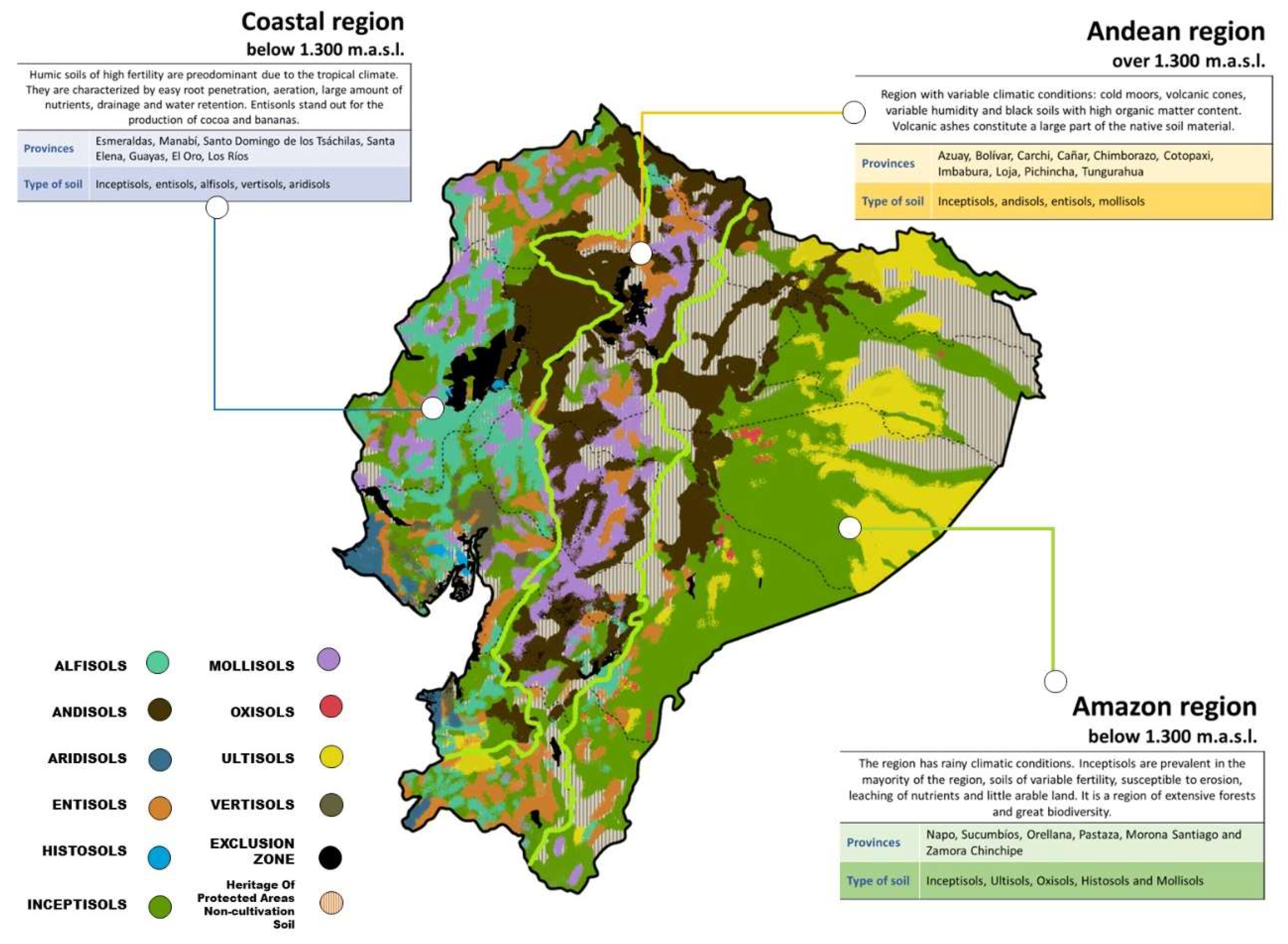

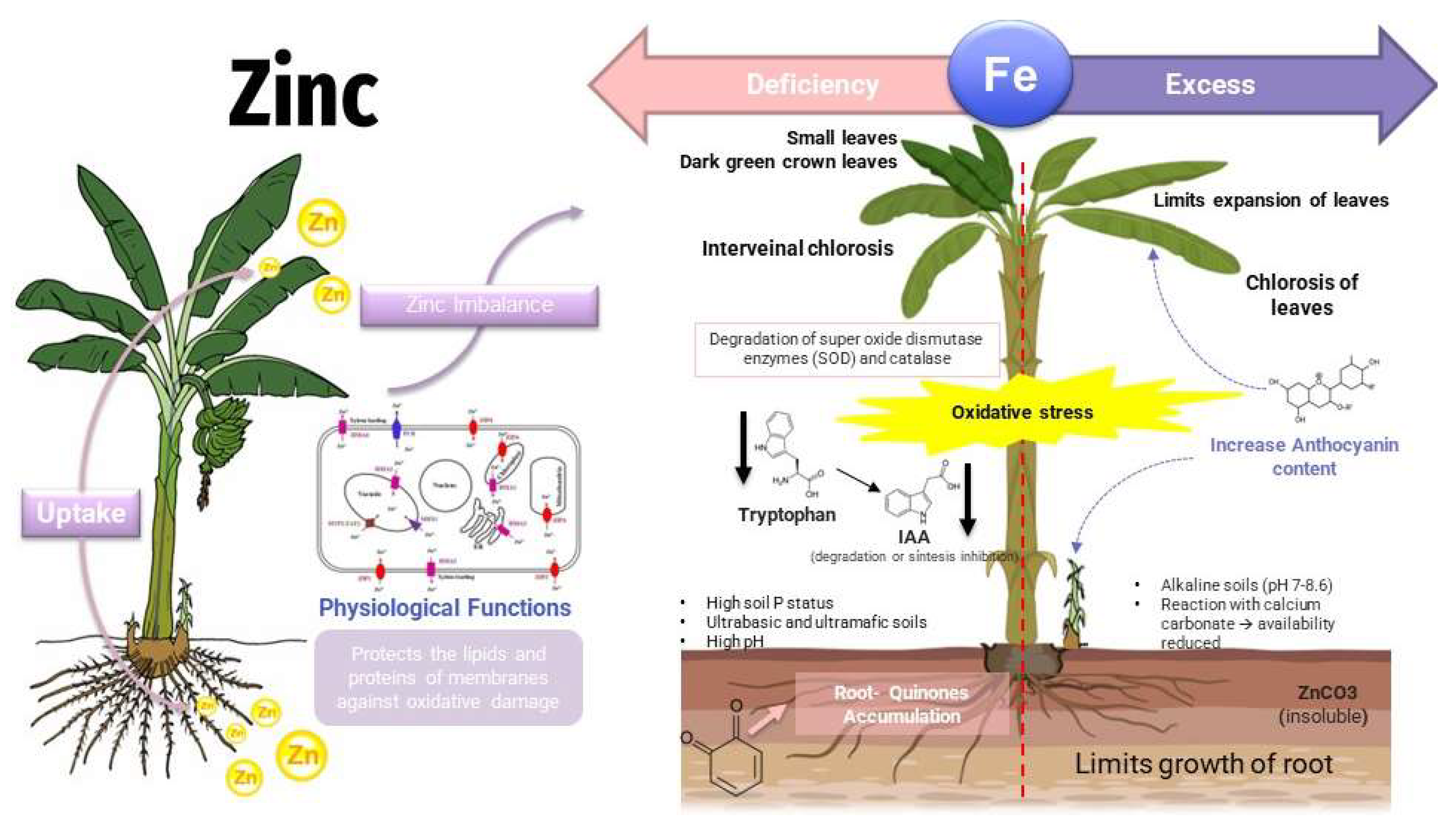
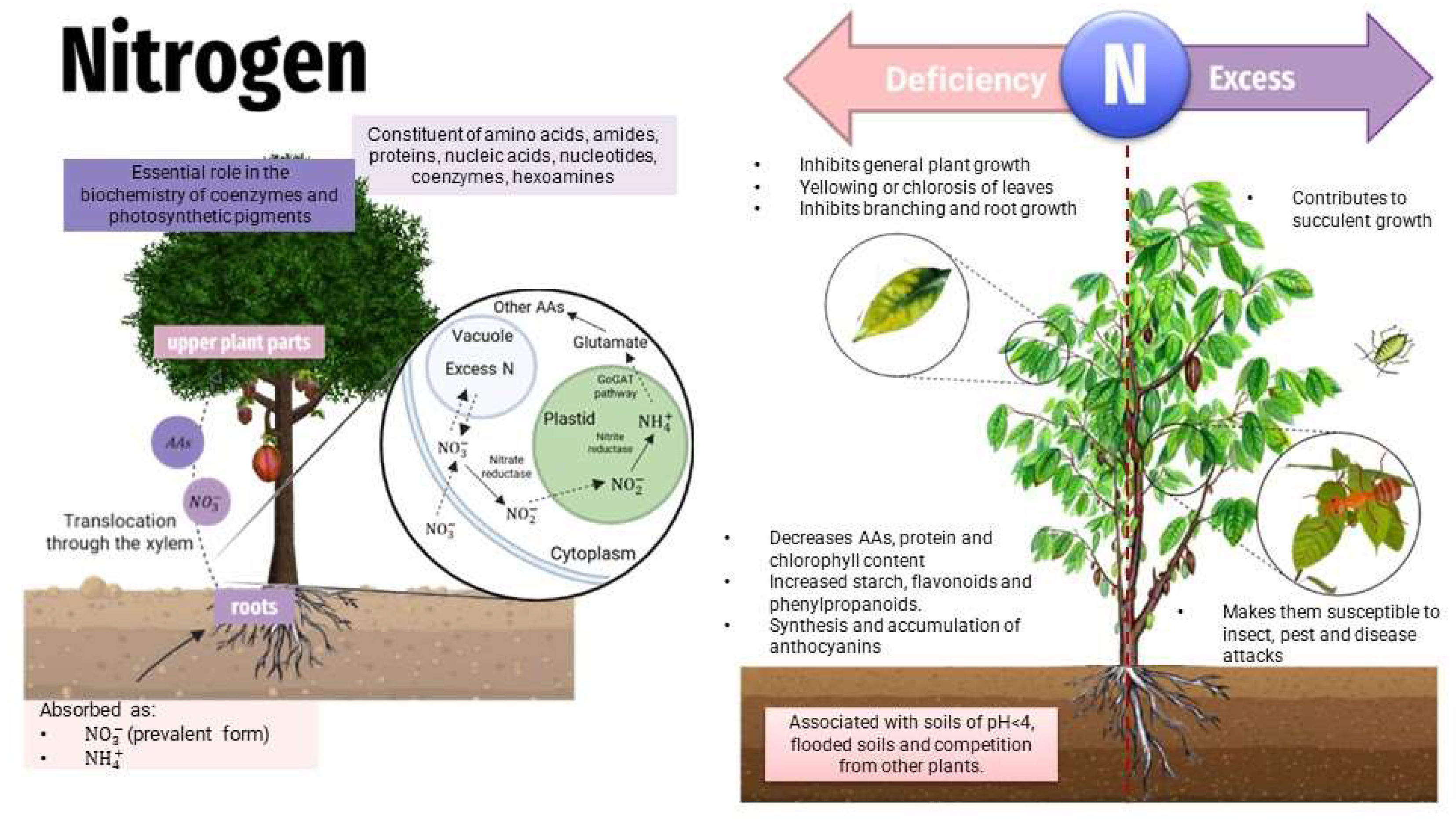
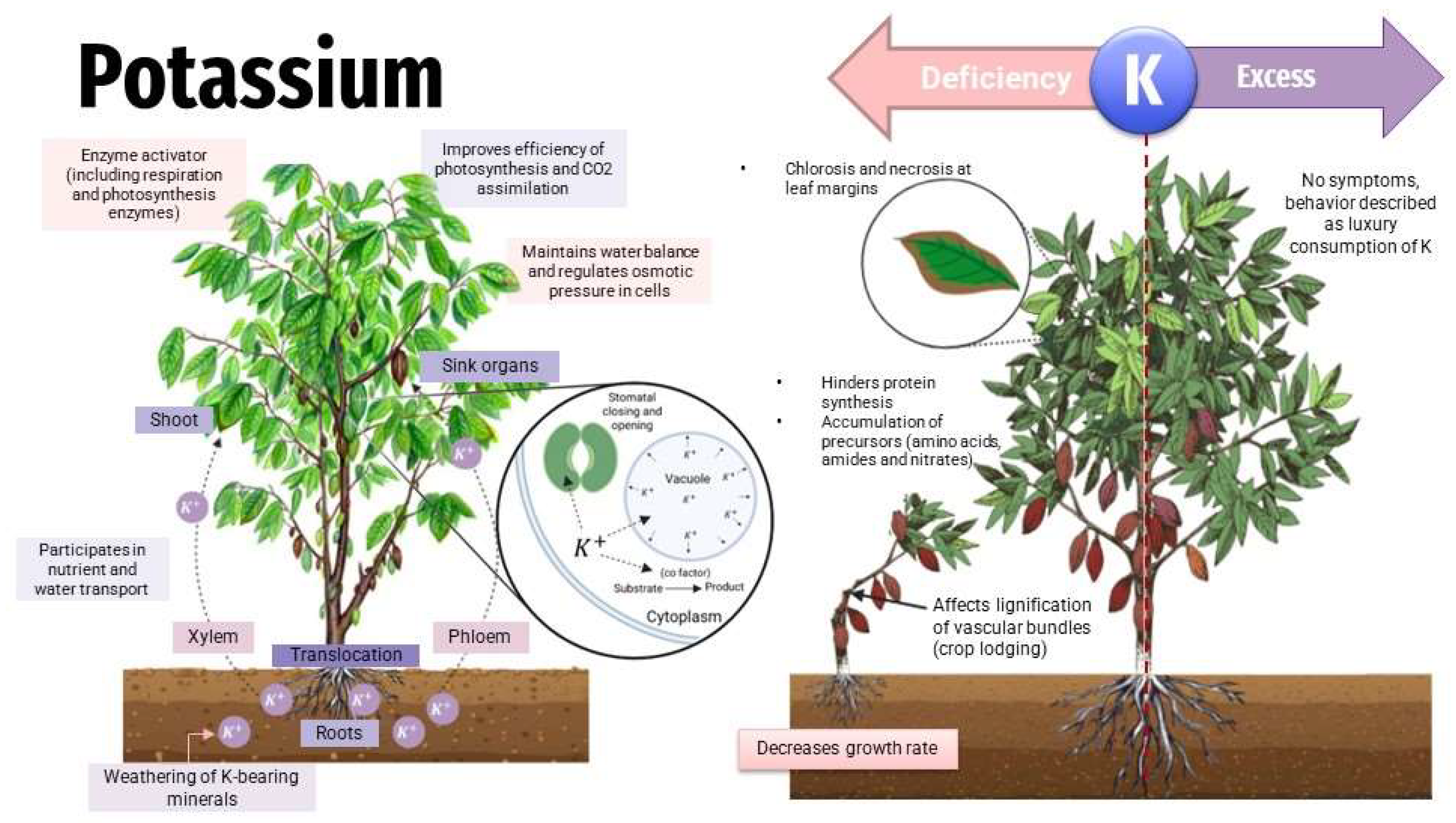
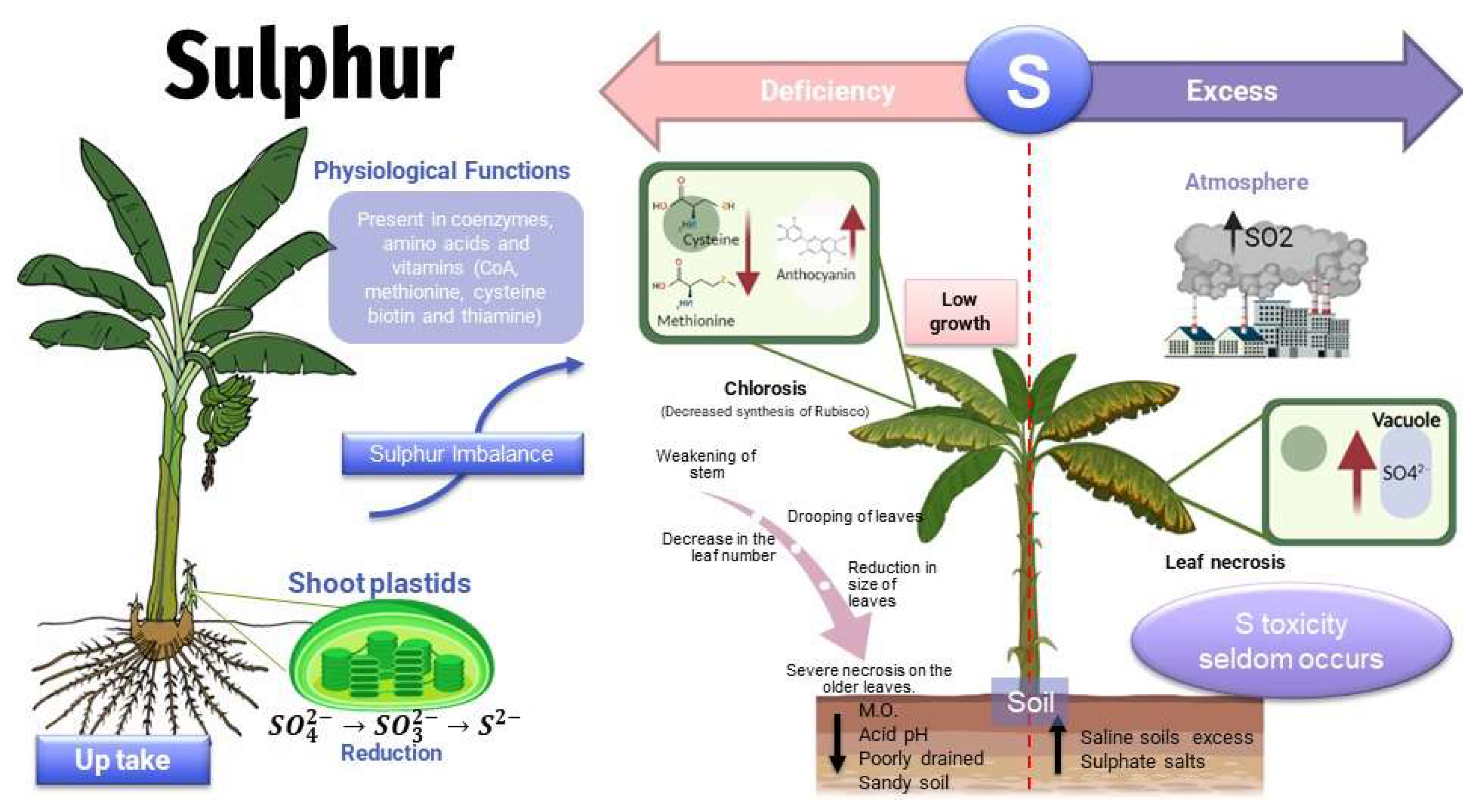
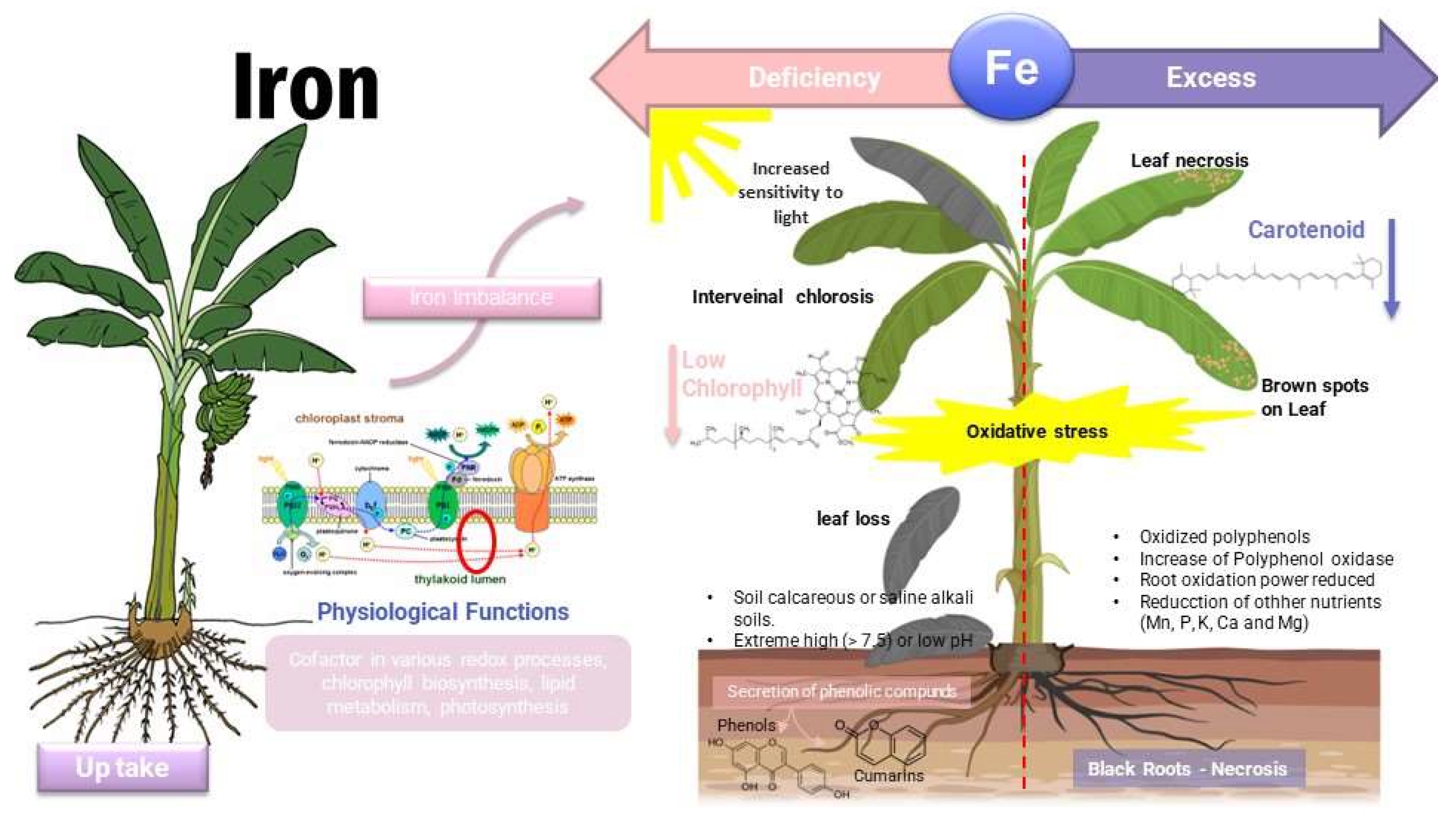
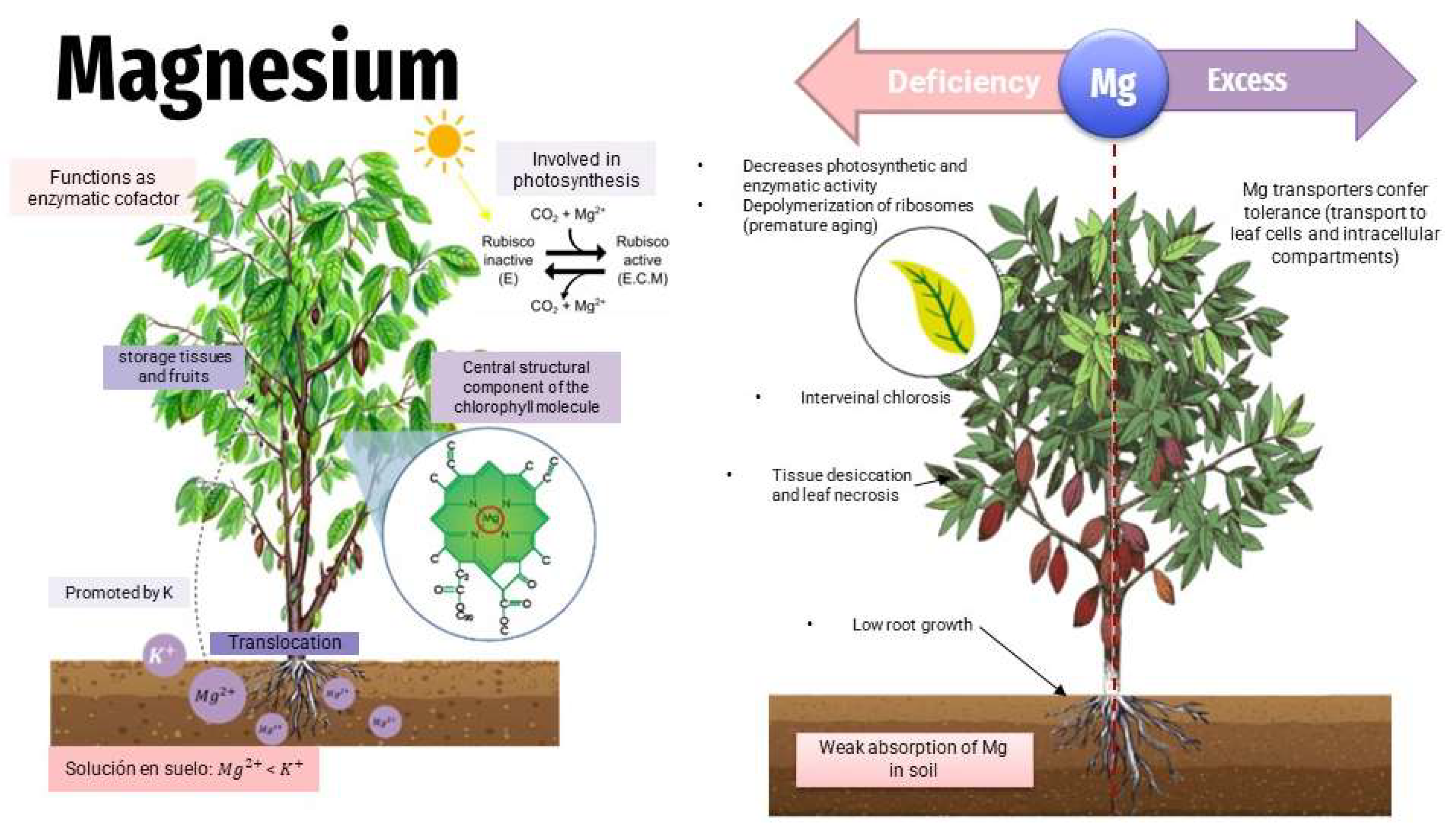
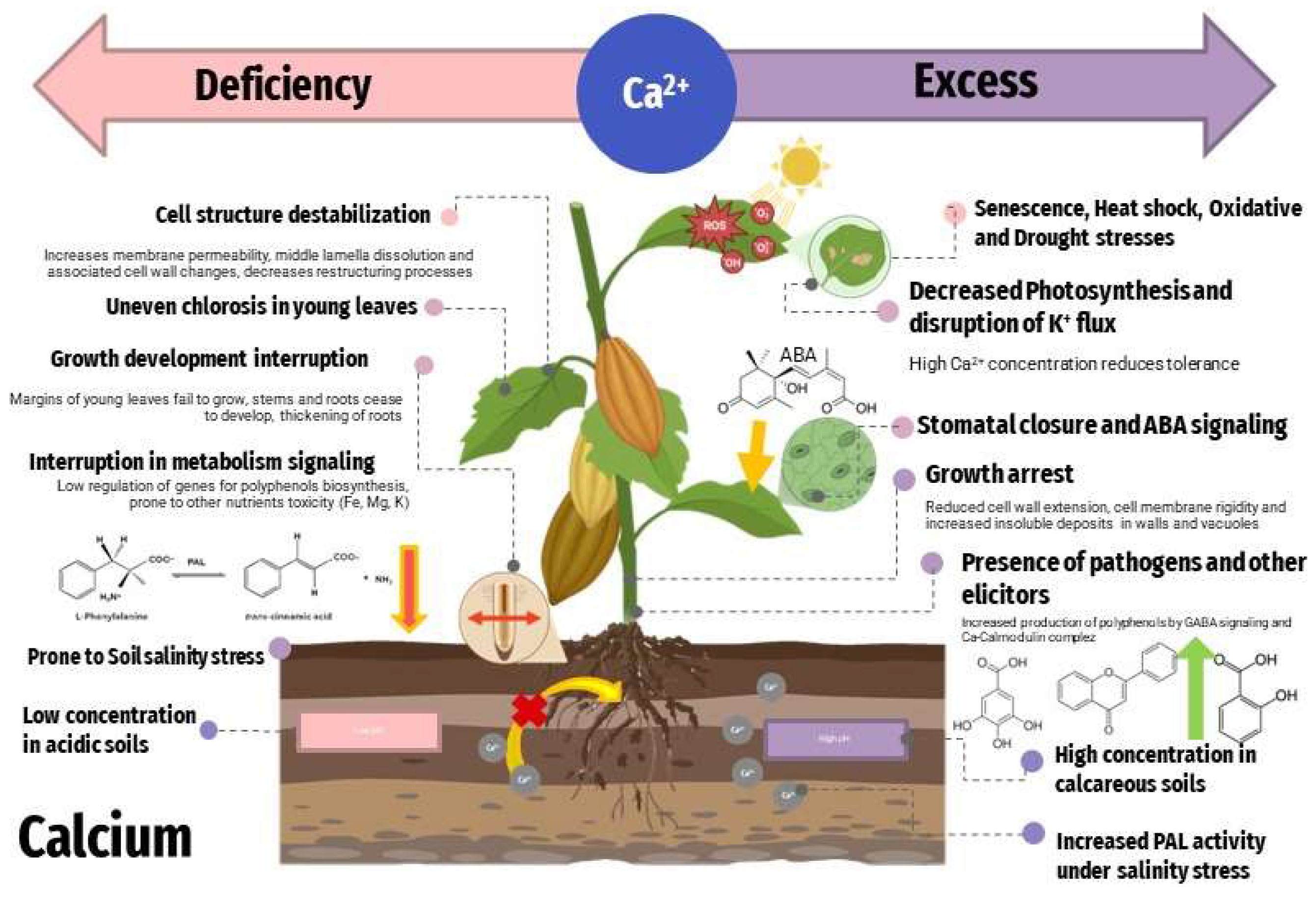
| Soil Orders | Characteristics |
|---|---|
| Alfisols |
|
| Andisols |
|
| Aridisols |
|
| Entisols |
|
| Histosols (peats) |
|
| Inceptisols |
|
| Mollisols |
|
| Oxisols |
|
| Ultisols |
|
| Crops | Edaphic Characteristics | Climatic Factors |
|---|---|---|
| Banana |
|
|
| Cocoa |
|
|
| African palm |
|
|
| Nutrient | Plant-Usable Form | Average Concentration in Plant Tissue | Biochemical Functions |
|---|---|---|---|
| Nutrients that are part of carbon compounds | |||
| N | 1.50% | Constituent of amino acids, amides, proteins, nucleic acids, nucleotides, coenzymes, hexoamines, etc. | |
| S | 0.10% | Component of cysteine, cystine, methionine, proteins, lipoic acid, biotin, coenzyme A, adenosine-5′-phosphosulphate, glutathione | |
| Nutrients that are important in energy storage or structural integrity | |||
| P | 0.20% | Component of sugar phosphates, nucleic acids, nucleotides, coenzymes, phospholipids, phytic acid, etc. Has a key role in reactions that involve ATP | |
| B | 20 mg/Kg | Complexes with mannitol, mannan, polymannuronic acid; constituents of cell walls; involved in cell elongation, nucleic acid metabolism | |
| Si | Deposited as amorphous silica in cell walls; contributes to cell wall mechanical properties (rigidity and elasticity) | ||
| Nutrients that remain in ionic form | |||
| K | 1.00% | Required as a cofactor for more than 40 enzymes, cation used in establishing cell turgor | |
| Ca | 0.50% | Constituent of the middle lamella of cell walls; second messenger in metabolic regulation; cofactor by some enzymes involved in ATP hydrolysis and phospholipids | |
| Mg | 0.20% | Required by many enzymes involved in phosphate transfer. Constituent of the chlorophyll molecule | |
| Cl | 100 mg/Kg | Required for the photosynthetic reactions involved in O2 evolution | |
| Mn | 20 mg/Kg | Required for activity of some dehydrogenases, decarboxylases, kinases, oxidases, and peroxidases. Involved with other cation-activated enzymes and photosynthetic O2 evolution | |
| Na | Involved with the regeneration of phosphoenolpyruvate in C4 and CAM plants.Substitutes for potassium in some functions | ||
| Nutrients that are involved in redox reactions | |||
| Fe | 100 mg/Kg | Constituent of cytochromes and non-haem iron proteins involved in photosynthesis, N2 fixation, and respiration | |
| Zn | 20 mg/Kg | Constituent of alcohol dehydrogenase, glutamic dehydrogenase, carbonic anhydrase, etc. | |
| Cu | 5 mg/Kg | Component of ascorbic acid oxidase, tyrosinase, monoamine oxidase, uricase, cytochrome oxidase, phenolase, laccase, and plastocyanin | |
| Mo | 0.1 mg/Kg | Constituent of nitrogenase, nitrate reductase, and xanthine dehydrogenase | |
| Ni | 0.1 mg/Kg | Constituent of urease. In N2-fixing bacteria, constituent of hydrogenases | |
| H | 6% | ||
| O | 45% | ||
| C | 45% | ||
Disclaimer/Publisher’s Note: The statements, opinions and data contained in all publications are solely those of the individual author(s) and contributor(s) and not of MDPI and/or the editor(s). MDPI and/or the editor(s) disclaim responsibility for any injury to people or property resulting from any ideas, methods, instructions or products referred to in the content. |
© 2023 by the authors. Licensee MDPI, Basel, Switzerland. This article is an open access article distributed under the terms and conditions of the Creative Commons Attribution (CC BY) license (https://creativecommons.org/licenses/by/4.0/).
Share and Cite
Mihai, R.A.; Melo Heras, E.J.; Terán Maza, V.A.; Espinoza Caiza, I.A.; Pinto Valdiviezo, E.A.; Catana, R.D. The Panoramic View of Ecuadorian Soil Nutrients (Deficit/Toxicity) from Different Climatic Regions and Their Possible Influence on the Metabolism of Important Crops. Toxics 2023, 11, 123. https://doi.org/10.3390/toxics11020123
Mihai RA, Melo Heras EJ, Terán Maza VA, Espinoza Caiza IA, Pinto Valdiviezo EA, Catana RD. The Panoramic View of Ecuadorian Soil Nutrients (Deficit/Toxicity) from Different Climatic Regions and Their Possible Influence on the Metabolism of Important Crops. Toxics. 2023; 11(2):123. https://doi.org/10.3390/toxics11020123
Chicago/Turabian StyleMihai, Raluca A., Erly J. Melo Heras, Vanessa A. Terán Maza, Iván A. Espinoza Caiza, Eliza A. Pinto Valdiviezo, and Rodica D. Catana. 2023. "The Panoramic View of Ecuadorian Soil Nutrients (Deficit/Toxicity) from Different Climatic Regions and Their Possible Influence on the Metabolism of Important Crops" Toxics 11, no. 2: 123. https://doi.org/10.3390/toxics11020123
APA StyleMihai, R. A., Melo Heras, E. J., Terán Maza, V. A., Espinoza Caiza, I. A., Pinto Valdiviezo, E. A., & Catana, R. D. (2023). The Panoramic View of Ecuadorian Soil Nutrients (Deficit/Toxicity) from Different Climatic Regions and Their Possible Influence on the Metabolism of Important Crops. Toxics, 11(2), 123. https://doi.org/10.3390/toxics11020123







